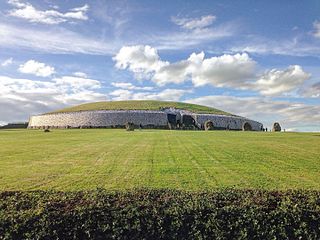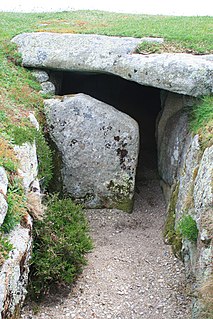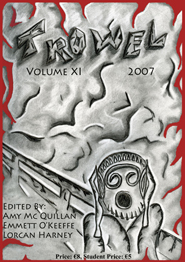 W
WThe prehistory of Ireland, pieced together from archaeological evidence, begins with the first evidence of humans in Ireland around 10,500 BC, and finishes with the start of the historical record around 400 AD. Both of these dates are later than for much of Europe and all of the Near East. The prehistoric period covers the Palaeolithic, Mesolithic, Neolithic, Bronze Age and Iron Age societies of Ireland. For much of Europe, the historical record begins when the Romans invaded; as Ireland was not invaded by the Romans its historical record starts later, with the coming of Christianity.
 W
WThe Bell Shrine of St. Cuileáin or Glankeen Bell is a mediaeval Irish bell shrine found near Borrisoleigh in County Tipperary, Ireland. Since 1854, it has been part of the British Museum's collection.
 W
WThe Chalice of Crossdrum is a lost Roman Catholic liturgical vessel.
 W
WThe court cairn or tomb is a megalithic type of chamber tomb and gallery grave, specifically a variant of the chambered cairn, found in western and northern Ireland, and in mostly southwest Scotland, around 4000–3500 BCE, but many remained in use until as late as the Bronze Age transition, c. 2200 BCE. They are generally considered to be the earliest chambered cairn tombs in Scotland, and their construction technique was probably brought from Scotland to Ireland. In Scotland, they are most common in what today are Argyll and Dumfries and Galloway, though a small outlying group have been found near Perth.
 W
WA crannog is typically a partially or entirely artificial island, usually built in lakes and estuarine waters of Scotland, Wales, and Ireland. Unlike the prehistoric pile dwellings around the Alps, which were built on the shores and not inundated until later, crannogs were built in the water, thus forming artificial islands.
 W
WThe Derrynaflan Chalice is an 8th- or 9th-century chalice, that was found as part of the Derrynaflan Hoard of five liturgical vessels. The discovery was made on 17 February 1980 near Killenaule, County Tipperary in Ireland. According to art historian Michael Ryan the hoard "represents the most complex and sumptuous expression of the ecclesiastical art-style of early-medieval Ireland as we know it in its eighth- and ninth-century maturity." The area known as Derrynaflan is an island of pastureland surrounded by bogland, which was the site of an early Irish abbey. The chalice was found with a composite silver paten, a hoop that may have been a stand for the paten, a liturgical strainer and a bronze basin inverted over the other objects. The group is among the most important surviving examples of Insular metalwork. It was donated to the Irish State and the items are now on display in the National Museum of Ireland.
 W
WEntrance grave is a type of Neolithic and early Bronze Age chamber tomb found primarily in Great Britain. The burial monument typically consisted of a circular mound bordered by a stone curb, erected over a rectangular burial chamber and accessed by a narrow, stone lined entrance. Entrance graves have been discovered in the Isles of Scilly, west Cornwall, southeast Ireland, southwest Scotland, Brittany and the Channel Islands. They are often referred to as the Scillonian' Group, named for the Scillian Islands where the majority of entrance graves have been discovered.
 W
WThe list of hoards in Ireland comprises the significant archaeological hoards of coins, jewellery, metal objects, scrap metal and other valuable items that have been discovered on the island of Ireland. It includes both hoards that were buried with the intention of retrieval at a later date, and also hoards of votive offerings which were not intended to be recovered at a later date, but excludes grave goods and single items found in isolation. The list is subdivided into sections according to archaeological and historical periods.
 W
WIrish round towers are early medieval stone towers of a type found mainly in Ireland, with two in Scotland and one on the Isle of Man. As their name Cloigtheach indicates, they were originally bell towers, though they may have been later used for additional purposes.
 W
WA leacht is a small square or rectangular stone structure often found in Early Irish Christian places of worship. They are typically made from rough, unmortared stones, and are most often found in monasteries on island off the west coast of Ireland. Their precise function is unknown, they may have been erected to mark burial places, or to honor a saint, or for use as an altar or place of prayer.
 W
WIn the Neolithic and Bronze Age British Isles, rock art was produced across various parts of the islands. Petroglyphic in nature, the majority of such carvings are abstract in design, usually cup and ring marks, although examples of spirals or figurative depictions of weaponry are also known. Only one form of rock art in Europe, this late prehistoric tradition had connections with others along Atlantic Europe, particularly in Galicia.
 W
WA promontory fort is a defensive structure located above a steep cliff, often only connected to the mainland by a small neck of land, thus using the topography to reduce the ramparts needed. Although their dating is problematic, most seem to date to the Iron Age. They are mainly found in Brittany, Ireland, the Orkney Islands, the Isle of Man, Devon and Cornwall.
 W
WRingforts, ring forts or ring fortresses are circular fortified settlements that were mostly built during the Bronze Age up to about the year 1000. They are found in Northern Europe, especially in Ireland. There are also many in South Wales and in Cornwall, where they are called rounds. Ringforts come in many sizes and may be made of stone or earth. Earthen ringforts would have been marked by a circular rampart, often with a stakewall. Both stone and earthen ringforts would generally have had at least one building inside.
 W
WThe Tara Brooch is a Celtic brooch of the pseudo-penannular type, made in 650 to 750 AD. It was found in Ireland in 1850, but, despite its name, not at Tara but likely near Bettystown on the coast of County Meath. The name by which it became known was attached to the brooch by the jeweller who purchased it, as a marketing ploy for the copies they made. The brooch was exhibited internationally and was one of the artifacts that fuelled the Celtic Revival in the mid-19th century. It is now on display in the National Museum of Ireland in Dublin.
 W
WTrowel is an academic journal published by postgraduate students at the School of Archaeology, University College Dublin, Ireland.
 W
WA gallery grave is a form of megalithic tomb built primarily during the Neolithic Age in Europe in which the main gallery of the tomb is entered without first passing through an antechamber or hallway. There are at least four major types of gallery grave, and they may be covered with an earthen mound or rock mound.